AT THE FEEDER
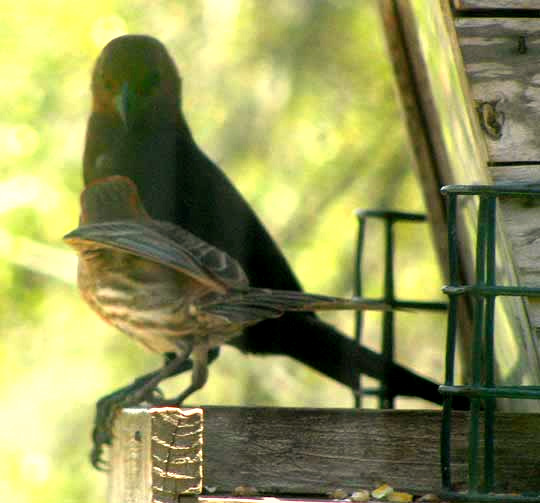
At the feeder birds do much more than simply gorge themselves. For example, it's interesting to watch how birds of different species get along. At the right, a Brown-headed Cowbird, Molothrus ater -- who happens not only to be big for a songbird, but also aggressive, and the female lays her eggs in the nests of other species, to the detriment of the "adopted family" -- menacingly stares down at a much smaller House Finch, Haemorhous mexicanus. The House Finch gamely responds with his "head forward" threat display, and seems to be raising his wings, making himself look larger. You may be interested in reviewing a freely available 1975 technical paper by Ronald Kalinoski entitled Intra- and Interspecific Aggression in House Finches and House Sparrows.
COURTSHIP
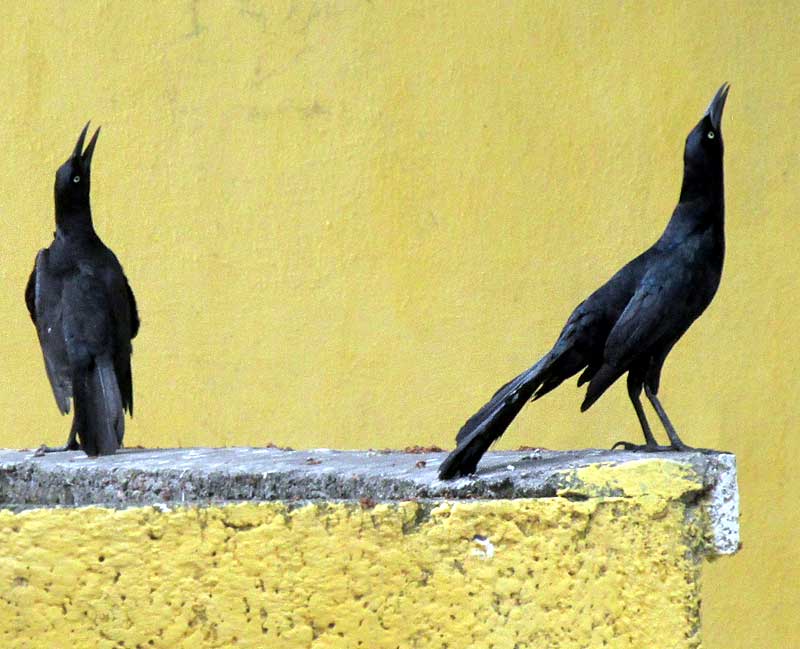
Courtship is that period starting when males and females first meet, until the time they mate. Behavior during courtship varies tremendously from species to species. Brightly colored male tanagers and orioles parade themselves before the females. Buntings flutter over fields, loudly singing. Woodpeckers drum with their bills on dead limbs and aluminum house-gutters. Male Cardinals ritually feed their potential mates, and male hummingbirds perform complex flying patterns as the female watches. Above, male Great-tailed Grackles, Quiscalus mexicanus, "sky-point" or "bill tilt" as a female watches. The male who tilts his head farthest back and holds it the longest presumably impresses the female the most, and becomes more attractive as a mate. In bird courtship, the general idea is for the male to attract and impress a female.
NEST BUILDING
A few species do not build nests. Oystercatchers, for instance, lay their eggs in shallow, unlined depressions dug with their feet in sandy beaches. Nighthawks may nest on bare, flat roofs of buildings. When birds do build nests, the nests vary from the hummingbirds' elegant little creations held together with cobwebs, to mud nests built by some swallows, to messy assemblages of sticks, straws, and other items, made by House Sparrows.
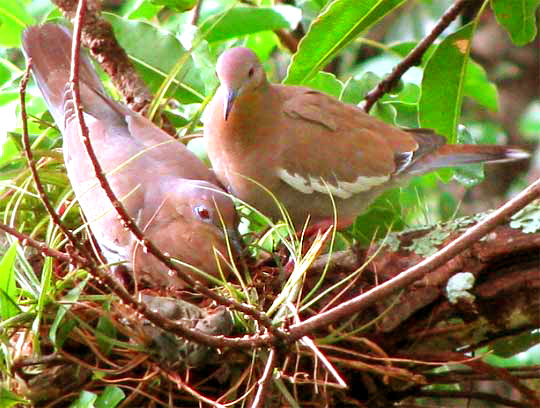
At the right, White-winged Doves, Zenaida asiatica, are beginning a nest. In this species, the male chooses the territory and general nesting area, but the female selects the exact nest location. The male presents twigs to the female, who constructs the nest during several days, maybe adding weeds, grass and other material as well.
Each species has its preferred nest-building materials, and some species can show surprising flexibility. A Warbling Vireo's nest was built almost entirely of Kleenex; in Minnesota a Brown Thrasher's nest was found with a five-dollar bill woven into the cup. In Texas, a White-necked raven built a nest completely of barbed wire. A pair of Canyon Wrens in California built a nest containing a total of 1,791 countable items -- all office supplies such as thumbtacks and rubber bands.
For a more detailed look at nest building, visit our bird-nest page.
FAMILY RAISING
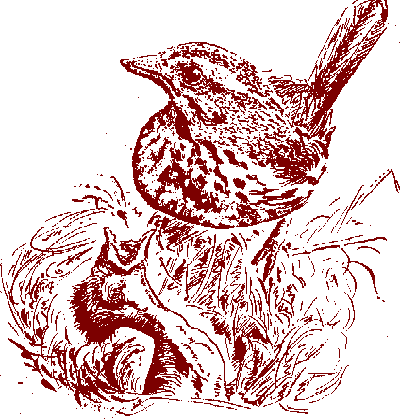
Family raising begins with egg-laying and continues through incubation, hatching, the time during which nestlings remain in their nest needing to be fed, and ends when the birds have become fledglings outside the nest, and no longer need their parents' help.
During this fast-paced period of development, birds can be the most conspicuous and interesting. If you find a nest with young birds in it, don't disturb it, else the parents may abandon it. If you want to protect a nest in your backyard, the best thing you can do is to keep the cat inside; nothing kills more backyard nestlings and fledglings than house cats and habitat destruction.
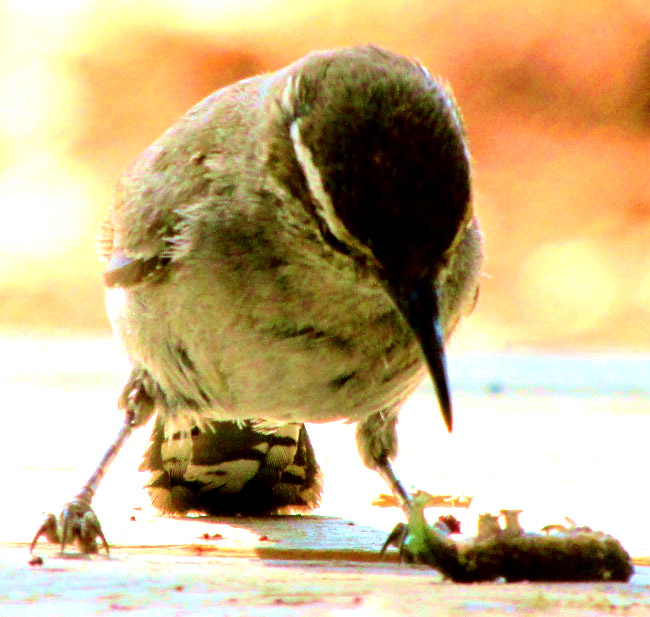
The Bewick's Wren, Thryomanes bewickii, at the left is "softening up" a caterpillar for feeding to a fledgling. Once the caterpillar was motionless and fairly limp, the bird flew away carrying it, issued a sharp "peep," and immediately a fledgling fluttered from a hidden spot in a bush to meet the parent on a projecting branch of what seemed to be an agreed-on bush. Immediately the caterpillar was plopped into the young one's gaping maw, the adult issued a quick, burbly call ending with a short trill, and zoomed off, presumably to find more food. Such encounters could be seen in the general area several times daily.
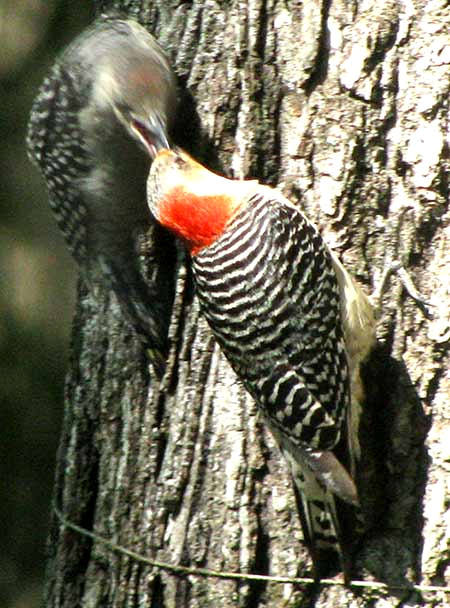
At the right, a Red-bellied Woodpecker mother has just landed on the trunk where the fledgling at the right was waiting. The mother opened her beak and the young bird seems to be reaching rather deeply for food. Often the adults dismember larger insects before presenting them.
During the young birds' fledgling stage, when they can almost but not quite fend for themselves, watch for the time when the parents are losing interest in constantly feeding them, yet the fledglings obviously prefer begging and being fed, to foraging for their own meals! Just try to avoid anthropomorphically interpreting moments of "frayed nerves," "temper tantrums," and "parents feeling guilty and making up"!
ESTABLISHING & DEFENDING TERRITORIES
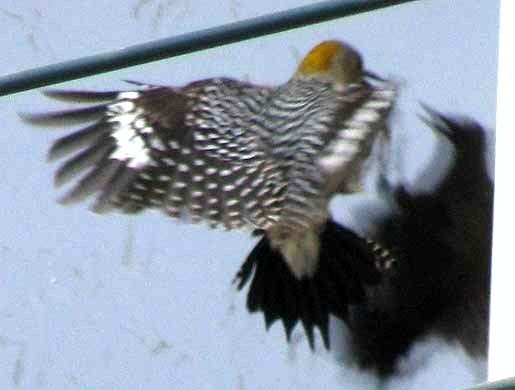
At the left, a female Golden-fronted Woodpecker, Melanerpes aurifrons, attacks her own reflection in a window, reacting to what seems to her an intruder into her family's territory. One thinks of females staying on nests while males defend the territory, but such details vary from species to species. Golden-fronted Woodpecker males incubate the eggs at night, while females incubate during the day. Both sexes have been seen clearing the nest of poop. Atop all that, this species is mostly monogamous throughout the breeding season, and the pair often stay together after the season ends.
COMMUNAL BEHAVIOR
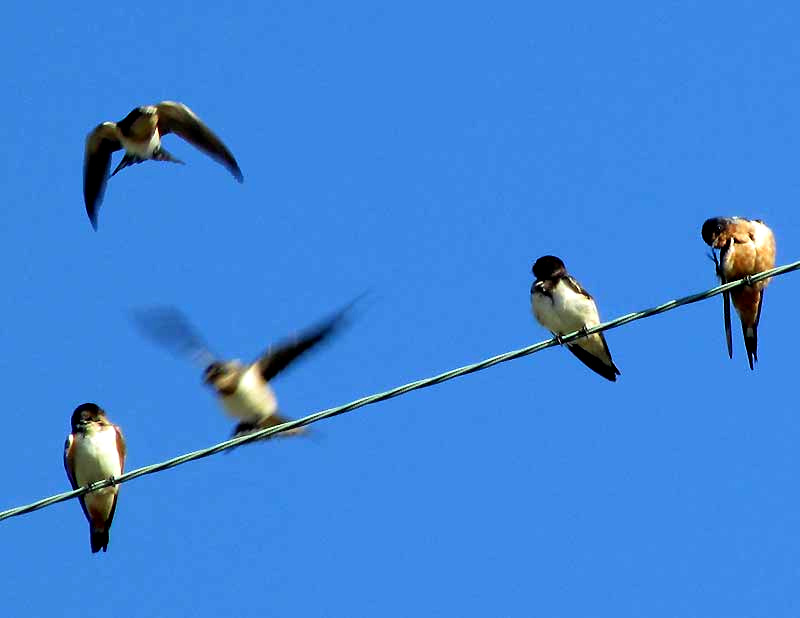
Birds often flock together, usually in groups of the same species but sometimes mixed species. Sometimes this communal behavior is seen only at certain seasons. At the right, Barn Swallow juveniles, Hirundo rustica, in their "post-fledging independence period" for several weeks perched on a certain wire across a stream in semi-desert country, basking in early morning sunlight, preening and flying about, before flying away for most of the day. Less than half of fledgling Barn Swallows survive this period. An interesting, freely available research paper by Keith Hobson describes this critical period in a Barn Swallow's life.
Communal behavior varies among the species. After the nesting season, for instance, American Robins undergo complete personality changes. No longer do they defend their territories and clash with their neighbors; now they flock together feeding and migrate southward together. In late summer, flocks of young House Sparrows roost together chirping and calling. During this highly social period you can see many forms of interaction. When you get interested in a certain species and notice them doing something unusual, it's fun to search on the Internet for explanation. For example, searching on the keywords "house sparrow communal behavior" summons several very interesting pages.